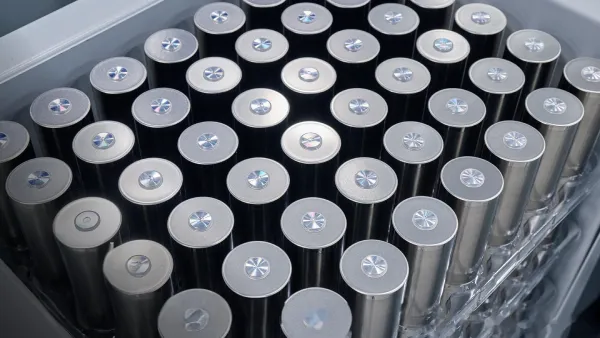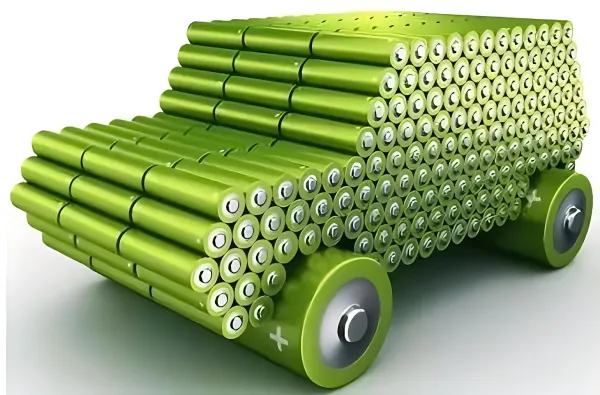Cylindrical batteries can be divided into lithium iron phosphate batteries, lithium cobalt oxide batteries, lithium manganate batteries, and cobalt-manganese hybrid batteries based on filler materials. According to the type of shell, cylindrical lithium batteries can be steel shell lithium batteries and polymer shell lithium batteries.

Part 1. Characteristics of cylindrical batteries
1. Appearance of cylindrical lithium battery
Cylindrical lithium batteries generally comprise positive electrode material (nickel cobalt oxide or zinc manganate), separator paper, and electrolyte. The casing of the cylindrical battery is made of aluminum-plastic composite pipe.
2. Cylindrical lithium battery capacity
The rated energy density of a single cylindrical lithium battery is between 300 and 500Wh/kg. Its specific power can reach more than 100W. According to different models and specifications of cylindrical batteries, the actual performance of this type of battery varies.
3. Safety and reliability of cylindrical lithium batteries
Cylindrical batteries have the characteristics of high safety and stability, resistance to overcharge, high temperature resistance, and long service life.
4. Cylindrical lithium battery application
Cylindrical lithium batteries can be used as power sources. In addition, they can also be seen in digital cameras, MP3 players, notebook computers, car starters, power tools, and other portable electronic products.
Part 2. Structure of cylindrical battery
A general cylindrical lithium-ion battery consists of a casing, a cap, a positive electrode, a negative electrode, a separator, and an electrolyte. Generally speaking, the casing of a cylindrical battery is the battery’s negative electrode, and the cap is the battery’s positive electrode. The battery casing is made of nickel-plated steel plate.
The critical difference between power cylindrical batteries and ordinary cylindrical batteries lies in the conductive connection structure of the battery. A special high-current structure design is required because the general application current of power lithium batteries is relatively large.
Part 3. 7 common types of cylindrical batteries
Cylindrical lithium batteries usually have a five-digit model number. Starting with the numbers on the left, the first and second numbers refer to the battery diameter. The third number refers to the battery height. The fifth number refers to the circle.
There are many models of cylindrical lithium batteries; the more common ones are 10440, 14500, 16340, 18650, 21700, 26650, and 32560.
1. 10440 battery
The 10440 battery is a lithium battery with a diameter of 10 mm and a height of 44 mm. It’s the same size as what we usually call an AA battery. The capacity of this kind of battery is generally very small, only a few hundred mah. This battery is mainly used in mini electronic products, such as flashlights, mini audio, speakers, etc.
2. 14500 battery
The 14500 battery is a lithium battery with a diameter of 14 mm and a height of 50 mm. This battery voltage is generally 3.7V or 3.2V. The nominal capacity of the 14500 battery is relatively small, a little larger than the 10440 battery, generally 1600mah. The 14500 battery has excellent discharge performance and is mainly used in consumer electronics, such as wireless audio, electric toys, digital cameras, etc.
3. 16340 battery
The 16340 battery is a lithium battery with a diameter of 16 mm and a height of 34 mm. This kind of battery often appears in bright flashlights, LED flashlights, headlights, laser, lighting lamps, etc. Because the 16340 battery is shorter in height, its capacity is a little small.
4. 18650 battery
The 18650 battery is a lithium battery with a diameter of 18 mm and a height of 65 mm. Its most prominent feature is that the energy density is very high, almost reaching 170 Wh/kg. Therefore, this battery is a very cost-effective battery. Most of the batteries we often see are this type of battery. Because it is a relatively mature lithium battery. 18650 battery has good system quality stability in all aspects. 18650 batteries can be widely used in battery capacity applications of about 10 kWh, such as mobile phones, laptops and other small appliances.
5. 21700 battery
The 21700 battery is a lithium battery with a diameter of 21 mm and a height of 70 mm. Due to its increased volume and increased space utilization, the energy density of battery cells and systems can be increased. The volume energy density of the 21700 battery is much higher than that of the 18650 battery, and it is widely used in digital, electric vehicles, balance vehicles, solar lithium battery street lights, LED lights, power tools, etc.
6. 26650 battery
The 26650 battery is a lithium battery with a diameter of 26mm and a height of 65mm. Its nominal voltage is 3.2V. The nominal capacity is 3200mah. 26650 batteries have excellent capacity and high consistency. It has gradually become an alternative trend to 18650 batteries, and will also gradually become popular in power batteries.
7. 32650 battery
The 32650 battery is a lithium-ion battery with a diameter of 32 mm and a height of 65 mm. This kind of battery has strong continuous discharge capability, so it is more suitable for electric toys and backup power supply. UPS battery, wind power generation system.
Part 4. Cylindrical battery voltage, capacity, charger and PCB
1. Rated voltage of cylindrical battery cells
3.7V/3.2V
2. Cylindrical battery cell capacity
Common cylindrical battery cell capacities are as follows:
- 10440 battery cell nominal capacity: 320mAh,
- 14430 battery cell nominal capacity: 500mAh-700mAh,
- 14500 battery cell nominal capacity: 600mAh-800mAh,
- 14650 battery cell nominal capacity: 1100mAh
- 16340 battery cell nominal capacity: 700mAh,
- 18350 battery cell nominal capacity: 900mAh,
- 18500 battery cell nominal capacity: 1200mAh-1600mAh,
- 18650 battery cell nominal capacity: 1000mAh, 1200mAh, 1500mAh, 1800mAh, 2000mAh, 2200mAh, 2500mAh, 2600mAh, 2900mAh, 3000mAh, 3250mAh, etc.
- 21700 battery cell nominal capacity: 4000mAh, 4500mAh, 4800mAh, etc.
- 26650 battery cell nominal capacity: 3000mAh, 3300mAh, 3400mAh, etc.
- 32650 battery cell nominal capacity: 6000mAh, etc.
3. Cylindrical battery pack voltage
Common cylindrical battery pack voltages are 3.2V, 3.7V, 6.4V, 7.4V, 9.6V, 11.1V, 12V, 14.8V, 22.2V, 24V, 36V, 48V, etc.
4. Cylindrical battery pack capacity
Common cylindrical battery pack capacities: 2AH, 4AH, 5AH, 6AH, 8AH, 10AH, 12AH, 15AH, 20AH, etc.
5. Cylindrical battery charger
Cylindrical battery chargers can be equipped according to different battery packs, and there is no specific charger.
6. Cylindrical battery PCB
Most cylindrical batteries have overcharge protection, overdischarge protection, short circuit protection, overcurrent protection, overheating protection and other functions to ensure battery safety.
Part 5. Cylindrical battery pros and cons

Advantages of cylindrical lithium batteries
- The cylindrical battery production process is mature, the PACK cost is low, the battery product yield is high, and the heat dissipation performance is good;
- Cylindrical batteries have formed a series of internationally unified standard specifications and models with mature technology and suitable for mass continuous production;
- The cylindrical battery has a large surface area and a good heat dissipation effect;
- Cylindrical batteries are generally sealed batteries, and there are no maintenance problems during use;
- The cylindrical battery shell has high voltage resistance and will not cause swelling of square or soft-packaged batteries during use.
Disadvantages of cylindrical lithium batteries
- The cylindrical lithium battery cell size is larger. When the current is discharged, the internal temperature of the winding core is relatively high.
- The activity at the edge of the cylindrical lithium battery pole piece is poor. Battery performance declines more obviously after long-term use.
- Cylindrical lithium batteries come in different sizes, resulting in poor versatility. The lamination process during battery production is uneven, resulting in poor consistency.
The above is a summary of all aspects of cylindrical batteries. Cylindrical lithium batteries are more suitable for large-volume automated combination production. Large-volume lithium-ion batteries such as electric bicycles and electric motorcycles are basically produced from cylindrical lithium batteries. Not only that, cylindrical lithium batteries are also recognized as green and healthy batteries. They are very environmentally friendly and can be used with confidence.
Part 6. FAQs
-
Are cylindrical lithium batteries more durable than prismatic cells?
Yes, their cylindrical shape and rigid casing make them more resistant to swelling and mechanical stress. -
What are the advantages of cylindrical lithium batteries?
They offer better heat dissipation and higher energy density and are often more cost-effective. -
Can cylindrical lithium batteries be used in various applications?
They are widely used in power tools, laptops, e-bikes, and even electric vehicles. -
How does the cathode material affect cylindrical battery performance?
Common cathode materials like NCA, NMC, and LFP offer different energy density, safety, and cost trade-offs. -
Are there any safety concerns with cylindrical lithium batteries?
Like all lithium batteries, they require proper protection circuits and handling to avoid short circuits, overheating, or damage. -
How should cylindrical lithium batteries be stored and transported?
They should be stored in a cool, dry place and transported according to relevant regulations for lithium batteries. -
Can cylindrical lithium batteries be recycled or disposed of safely?
Yes, they can be recycled, but proper disposal methods are required to avoid environmental hazards. -
What is the typical lifespan of a cylindrical lithium battery?
Their lifespan depends on usage patterns, but they typically last 2-5 years with proper care and maintenance. -
Are cylindrical lithium batteries more or less expensive than other types?
Generally, they are more cost-effective than prismatic or pouch cells, especially for high-volume applications.
Related Tags:
More Articles

Overview of Deep Cycle Lithium Battery
In this article, we explore the life, voltage, capacity, and charging considerations of deep cycle lithium batteries.
How Long do Lithium Batteries Last?
How long do lithium batteries last? we will explore the factors that influence the lifespan of lithium batteries and provide insights into their longevity.
How to Choose the Best LiFePO4 Battery?
Choose LiFePO4 batteries for superior performance, safety, and versatility in EVs, UPS, and backup power. This guide helps you make informed decisions.
Get 12v Lithium Car Battery As a Power Source for the Ride
Make the right choice for your vehicle's battery needs by installing a 12 volt lithium car battery. You will enjoy maintenance-free longevity with this change.
Everything About A Small Lithium Ion Battery
Discover the features, uses & future potential of a small lithium ion battery. A compact and tiny powerhouse ideal for smartphones, wearables, drones & more.





